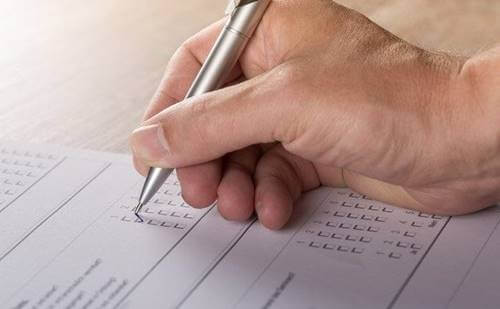The Psychopathy Checklist by Robert Hare


Written and verified by the psychologist Valeria Sabater
The psychopathy checklist or PCL-R is an international reference instrument to identify the presence of psychopathy in an individual. Above all, researchers use it within prison inmates, but it’s also useful in the clinical and forensic field. This is a reliable and valid test capable of providing interesting information about affective and interpersonal aspects and behavior problems, among other things.
This is perhaps one of the most interesting clinical resources due to the person who designed it. Its creator, Robert Hare, is a doctor of psychology and professor. As of now, he still stands as a reference in the field of criminal studies. His works in the area of psychopathology and psychophysiology are outstanding.
When creating this instrument, he attempted to design a resource capable of offering valuable information about those convicted of committing violent acts. Now, it didn’t take long for it to become successful due to two things. First of all, it was very simple and easy to administer. There are 20 items (questions) where the evaluator can compare the individual’s profile with that of a prototypical psychopath.
The second reason why Robert Hare’s psychopathy test was so accepted is because it could be used beyond the criminal population.
Thus, in a clinical setting, people began to see it as a simple and valid tool to evaluate possible violent tendencies, as well as sexual aggressiveness in men, women, and adolescents. In other words, it was able to estimate (with a reasonable error threshold) how likely it was for a certain person to commit a criminal act.
Let’s expand on this some more.

The psychopathy checklist: Purpose, application, and reliability
One of the best books on psychopathic personality is Without Conscience: The Disturbing World of the Psychopaths Among Us, written by Robert Hare and published in 2003. In this book, the author describes his extensive experience in this field. The story of this book begins since he was a psychology student. Back then, he’d carry out his practices in prisons, which made him very interested in the criminal world.
Hare states in the pages of this book that psychopaths (unlike sociopaths) aren’t made but born. Maybe this is why he found it necessary to develop an instrument to evaluate those underlying factors that, according to him, are present in approximately 1% of the population. The psychopathy checklist, therefore, came as a result of his practical experience, studies, interviews, and forensic cases.
“Psychopaths are social predators, and like all predators, they are looking for feeding grounds. Wherever you get power, prestige and money, you’ll find them.”
-Robert D. Hare-
What does the psychopathy checklist evaluate?
The psychopathy checklist or the PCL-R is used to assess the presence or absence of psychopathic traits in an individual for clinical, legal, or research purposes. This test was created in the 1990s and it was initially effective in assessing a person’s psychopathic tendencies. However, little by little, Hare and his team of researchers decided to take a closer look.
The reason for this was due to a recurring fact: the majority of psychopaths repeat their violent acts. Therefore, the creation of the current PCL-R came to be so that researchers could to see the potential risk of a convicted subject to relapse and repeat their past actions.

How experts apply this instrument
There are 20 items in the psychopathy checklist. In fact, it’s an evaluation scale. In other words, it’s applied through a semi-structured interview where the professional must assess between 0 and 2 points each question asked. On other hand, we must note that the result of this evaluation doesn’t only start with the interview. There are other important factors the researcher should consider such as the person’s criminal record, reports from experts, work and family history, trial records, and peer assessments, among others.
Let’s see the dimensions assessed in the psychopathy checklist:
- Loquacity / Superficial charm.
- Egocentrism / Great feeling of self-worth.
- Need for stimulation / Tendency to boredom.
- Pathological lying.
- Cunning / Manipulative.
- Lack of remorse and guilt.
- Emotionally shallow.
- Callous / Lack of empathy.
- Parasitic lifestyle.
- Lack of behavioral control.
- Promiscuous sexual behavior.
- Early behavioral problems.
- Lack of realistic long-term goals.
- Impulsiveness.
- Irresponsibility.
- Inability to accept responsibility for own actions.
- Several brief marital relations.
- Juvenile delinquency.
- Revocation of conditional release.
- Criminal versatility.
According to interviews and the analysis of several reports, researchers have come to the conclusion that completing this test takes about an hour and a half. The results obtained will define if there are psychopathic tendencies in the individual or not. In addition to that, they determine their significance and the possibility of committing violent acts (or of committing them again if they already did so).

Reliability and validity of the psychopathy checklist
Robert Hare points out that, with this test, it’s also possible to see the kind of psychopath we’re facing. It’s important to point out that not all psychopaths kill or commit violent acts. Many of them are defined only by a manipulative and narcissistic personality, which hinders both coexistence and identification.
On the other hand, if we ask ourselves now about the reliability of the psychopathy checklist, we must mention the analyzes carried out in the last years. The data always shows high consistency, validity, and reliability. Let’s mention, for example, the study conducted at Carleton University in Ottawa, Canada. In this study, Dr. Kristopher J. Brazil demonstrated, once again, its usefulness in the forensic, clinical, and research fields.
Without a doubt, this is a very interesting instrument. Robert Hare, meanwhile, is 85 years old today and is still one of the great experts in the field of psychopathy and criminal behavior.
“Psychopaths view any social exchange as a ‘feeding opportunity’, a contest or a test of wills in which there can only be one winner. Their motives are to manipulate and take, ruthlessly and without remorse.”
-Robert D. Hare-
The psychopathy checklist or PCL-R is an international reference instrument to identify the presence of psychopathy in an individual. Above all, researchers use it within prison inmates, but it’s also useful in the clinical and forensic field. This is a reliable and valid test capable of providing interesting information about affective and interpersonal aspects and behavior problems, among other things.
This is perhaps one of the most interesting clinical resources due to the person who designed it. Its creator, Robert Hare, is a doctor of psychology and professor. As of now, he still stands as a reference in the field of criminal studies. His works in the area of psychopathology and psychophysiology are outstanding.
When creating this instrument, he attempted to design a resource capable of offering valuable information about those convicted of committing violent acts. Now, it didn’t take long for it to become successful due to two things. First of all, it was very simple and easy to administer. There are 20 items (questions) where the evaluator can compare the individual’s profile with that of a prototypical psychopath.
The second reason why Robert Hare’s psychopathy test was so accepted is because it could be used beyond the criminal population.
Thus, in a clinical setting, people began to see it as a simple and valid tool to evaluate possible violent tendencies, as well as sexual aggressiveness in men, women, and adolescents. In other words, it was able to estimate (with a reasonable error threshold) how likely it was for a certain person to commit a criminal act.
Let’s expand on this some more.

The psychopathy checklist: Purpose, application, and reliability
One of the best books on psychopathic personality is Without Conscience: The Disturbing World of the Psychopaths Among Us, written by Robert Hare and published in 2003. In this book, the author describes his extensive experience in this field. The story of this book begins since he was a psychology student. Back then, he’d carry out his practices in prisons, which made him very interested in the criminal world.
Hare states in the pages of this book that psychopaths (unlike sociopaths) aren’t made but born. Maybe this is why he found it necessary to develop an instrument to evaluate those underlying factors that, according to him, are present in approximately 1% of the population. The psychopathy checklist, therefore, came as a result of his practical experience, studies, interviews, and forensic cases.
“Psychopaths are social predators, and like all predators, they are looking for feeding grounds. Wherever you get power, prestige and money, you’ll find them.”
-Robert D. Hare-
What does the psychopathy checklist evaluate?
The psychopathy checklist or the PCL-R is used to assess the presence or absence of psychopathic traits in an individual for clinical, legal, or research purposes. This test was created in the 1990s and it was initially effective in assessing a person’s psychopathic tendencies. However, little by little, Hare and his team of researchers decided to take a closer look.
The reason for this was due to a recurring fact: the majority of psychopaths repeat their violent acts. Therefore, the creation of the current PCL-R came to be so that researchers could to see the potential risk of a convicted subject to relapse and repeat their past actions.

How experts apply this instrument
There are 20 items in the psychopathy checklist. In fact, it’s an evaluation scale. In other words, it’s applied through a semi-structured interview where the professional must assess between 0 and 2 points each question asked. On other hand, we must note that the result of this evaluation doesn’t only start with the interview. There are other important factors the researcher should consider such as the person’s criminal record, reports from experts, work and family history, trial records, and peer assessments, among others.
Let’s see the dimensions assessed in the psychopathy checklist:
- Loquacity / Superficial charm.
- Egocentrism / Great feeling of self-worth.
- Need for stimulation / Tendency to boredom.
- Pathological lying.
- Cunning / Manipulative.
- Lack of remorse and guilt.
- Emotionally shallow.
- Callous / Lack of empathy.
- Parasitic lifestyle.
- Lack of behavioral control.
- Promiscuous sexual behavior.
- Early behavioral problems.
- Lack of realistic long-term goals.
- Impulsiveness.
- Irresponsibility.
- Inability to accept responsibility for own actions.
- Several brief marital relations.
- Juvenile delinquency.
- Revocation of conditional release.
- Criminal versatility.
According to interviews and the analysis of several reports, researchers have come to the conclusion that completing this test takes about an hour and a half. The results obtained will define if there are psychopathic tendencies in the individual or not. In addition to that, they determine their significance and the possibility of committing violent acts (or of committing them again if they already did so).

Reliability and validity of the psychopathy checklist
Robert Hare points out that, with this test, it’s also possible to see the kind of psychopath we’re facing. It’s important to point out that not all psychopaths kill or commit violent acts. Many of them are defined only by a manipulative and narcissistic personality, which hinders both coexistence and identification.
On the other hand, if we ask ourselves now about the reliability of the psychopathy checklist, we must mention the analyzes carried out in the last years. The data always shows high consistency, validity, and reliability. Let’s mention, for example, the study conducted at Carleton University in Ottawa, Canada. In this study, Dr. Kristopher J. Brazil demonstrated, once again, its usefulness in the forensic, clinical, and research fields.
Without a doubt, this is a very interesting instrument. Robert Hare, meanwhile, is 85 years old today and is still one of the great experts in the field of psychopathy and criminal behavior.
“Psychopaths view any social exchange as a ‘feeding opportunity’, a contest or a test of wills in which there can only be one winner. Their motives are to manipulate and take, ruthlessly and without remorse.”
-Robert D. Hare-
All cited sources were thoroughly reviewed by our team to ensure their quality, reliability, currency, and validity. The bibliography of this article was considered reliable and of academic or scientific accuracy.
- Allport, G, W. (1961). The Hare Psychopathy Checklist – Revised. Toronto Multihealth Systems. Holt, Rinchart & Winst. https://doi.org/10.1037/t01167-000
- Hare, R., Hart, S. y Harpur,T. (1991). Psychopathy and the DSM-IV Criteria
for Antisocial Personality Disorder. Journal of Abnormal Psychology. Vol.100(3), pp. 391-398
This text is provided for informational purposes only and does not replace consultation with a professional. If in doubt, consult your specialist.







